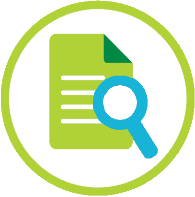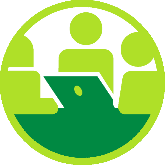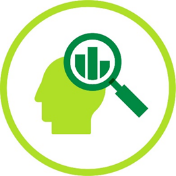
This factsheet discusses key technology and tools that your local government can use to measure, analyze and make decisions about its community tree canopy. It provides an overview of the different technologies and tools that can be used in urban forestry and how to decide which are most useful for your local context.
This factsheet was created to support small and rural communities who are just developing their urban forestry approaches and content might be helpful for municipal staff working in various departments such as public works, recreation or public health services.
Why does collecting data about community canopies matter?
In urban forestry, technology is changing the way communities manage their tree canopies. From geographic information systems (GIS) to light detection and ranging (LiDAR) technology, a suite of tools and software applications can provide data and analytical capacities that enable communities to map, monitor and maintain their urban forests with increasing precision and efficiency.
Data provides valuable insights into the current state of urban forests. For example, collecting data about how trees are distributed across a community helps identify where trees need to be planted, replaced or protected. This can be compared against canopy cover targets and used to explore equity in the distribution of canopy benefits or to assess the value of trees as natural assets. Data-driven approaches can also help illustrate the value of trees to the broader community, raising awareness and fostering support for conservation efforts and community engagement.
Key considerations for data collection and tool selection
Choosing the best tools for managing community canopies relies on understanding what data you need as well as a tool’s purpose, its technical capabilities and your budget. Different tools require different data inputs, so it’s best to select those that will help you generate the insights you need based on the data you have or can collect.
Here are some questions you can ask to help determine the most suitable tools for effective urban forest planning and management:
- What do you intend to use the tool for? How will it help you collect or interpret data about your community’s urban forest?
- What is the data input required for the tool you want to use? Does it have any hardware and/or software requirements?
- Will the tool work in your community or geographic region? Is it accessible to all stakeholders and rightsholders?
- How user-friendly is the tool? Is it easy to integrate with existing systems and workflows? Does it require any technical training? Is there any technical support for users?
- What are the tool’s initial investment costs? Are there ongoing maintenance and support fees? Is adopting it likely to create savings or efficiencies?
- Does the tool adhere to the community’s data security and privacy standards and ensure that sensitive information is well protected? Does the tool include any security measures or back-up protocols for data integrity and safety?

Technologies and tools for data collection and analysis
This section summarizes the key applications of technologies and tools that can be used to collect and analyze data for managing your community’s tree canopies.
Satellite or aerial imagery
Satellite imagery is collected by satellites orbiting the planet, operated by governments and businesses. Aerial imagery comes from photos taken from aircraft or other airborne platforms, such as drones. Orthophoto or ortho-imagery is a computer-generated image of an aerial photo that corrects any distortions due to terrain or camera angles.
Satellite or aerial imagery is commonly used to:
- Map tree canopy cover with a reasonable level of accuracy
- Understand the type, structure and health of a community canopy
- Detect tree canopy gains or losses and other land cover changes over time
- Measure land surface temperature and evaluate a community’s vulnerability to climate change
- Estimate tree canopy benefits, such as removal of carbon dioxide or air pollution
There are numerous data sources and tools that allow you to access and analyze satellite or aerial imagery. A few free examples include:
- Download imagery from the United States Geological Survey or European Space Agency
- View and analyze land cover imagery using Google Maps, Google Earth, Dynamic World, Esri Land Cover Explorer or i-Tree Canopy
Light detection and ranging (LiDAR)
LiDAR technology employs laser light to map ground surface, such as trees and buildings, from the air. It is one of the most accurate remote sensing techniques to collect data on terrain and any features on the Earth’s surface.
LiDAR technology is commonly used to:
- Map tree canopy cover
- Estimate tree count
- Understand structural attributes (e.g., tree height)
- Map impermeable and permeable surfaces (e.g., as potential planting spaces)
LiDAR requires purchasing data, possibly paying for software and technical training or consulting services for data processing. LiDAR data should be collected during leaf-on seasons to accurately estimate tree canopy cover.
Geographic information systems (GIS)
GIS is a technology platform used to capture, store, manage, analyze and visualize spatial and geographic data. GIS can integrate various types of data into a single digital environment, such as maps, satellite imagery, aerial photos, demographic information and tree inventory data. This helps users explore, interpret and understand spatial relationships and patterns.
GIS technology is commonly used to:
- Map, calculate and display tree canopy cover
- Map, analyze and display selected features or patterns of interest (e.g., parks, deciduous trees or accessibility of green spaces)
- Collect, store and manage tree inventory data
- Understand urban forest distribution and tree equity
- Share information and engage with stakeholders or rights holders via GIS-based interactive platforms
Technical training or hiring personnel with experience using GIS programs may be required. Most programs require a paid subscription. GIS programs range from general software applications to specialized applications that can help you share information and engage stakeholders, collect tree inventory data, or store, display and manage tree inventory data.
You can also use GIS technology to analyze and display other types of data that may inform your urban forest management plan. For example, mapping temperature data to identify areas prone to the urban heat island effect can influence decisions about where to plant new trees.
Emerging technologies and tools
Drones (unmanned aerial vehicles)
Drones, also called unmanned aerial vehicles (UAVs), are increasingly being used in urban forestry to collect detailed data such as high-resolution photos and thermal infrared imagery. UAVs’ ability to gather site-specific information quickly and cost-effectively makes this emerging tool a valuable one for monitoring tree health and conducting tree inventories and rapid assessments in urban areas.
Street-view imagery
Street-view imagery is another emerging data source for understanding urban landscapes from a human perspective, complementing remote sensing methods like LiDAR. It is increasingly studied and used to assess near-street greenery, assist in tree inventory when resources are limited and engage the public.
Ground-based sensors
Ground-based sensors like thermal imaging, soil moisture and acoustic sensors are increasingly being used to monitor urban forest parameters and site conditions. They can provide detailed information on tree health and environmental factors crucial for healthy tree growth.
Data management and decision-making tools
Data-management and decision-making tools are designed to display information and assess performance over time, allowing local governments and communities to evaluate the current conditions of the urban forest, monitor progress and trends, and make informed decisions to improve outcomes.
There are numerous applications that can be used to evaluate the performance of your urban forest management program against established best practices and benchmarks. For example:
- Vibrant Cities Lab has developed a Community Assessment and Goal-Setting Tool for tree canopies that can be used to benchmark, measure against best practices and monitor progress over time.
- Sustainable Forestry Initiative has developed an Urban and Community Forest Sustainability Standard to guide and evaluate the sustainability efforts of organizations managing urban or community forests.
- NatureScore, developed by NatureQuant, measures the amount and quality of natural elements at any location and their potential health impacts using a unique system that incorporates satellite data, GIS classification, park features, tree cover, pollution levels and machine-learning algorithms.
Opportunities to involve the community
Deciding on which tools and technologies to use is largely dependent on your data needs, priorities and budget. However, there may be opportunities to involve the broader community in data collection and analysis, such as working with volunteers, academic institutions or other research groups. Citizen science applications like iNaturalist allow community members to record and share observations on local plants and animals, which can inform decision-making about the urban forest.
Community engagement can help you set priorities for your analysis by understanding which tree canopy characteristics are valued by the community and therefore important to track and report on. The use of different technologies to display and communicate information about your local tree canopy can also be an important part of broader engagement strategies around the benefits of trees.
Next steps
Here are additional resources that can help you get started with selecting tools and technologies:
- Tree Canada, Compendium of Best Urban Forest Management Practices: Chapter 7. GIS and Other Technologies
- Nature Canada, Canada’s Urban Forests: Bringing the Canopy to All
This resource was created in partnership by Tree Canada and FCM’s Green Municipal Fund for the Growing Canada’s Community Canopies initiative, which is delivered by the Federation of Canadian Municipalities and funded by the Government of Canada.



 Why does collecting data about community canopies matter?
Why does collecting data about community canopies matter?  Key considerations for data collection and tool selection
Key considerations for data collection and tool selection  Data management and decision-making tools
Data management and decision-making tools